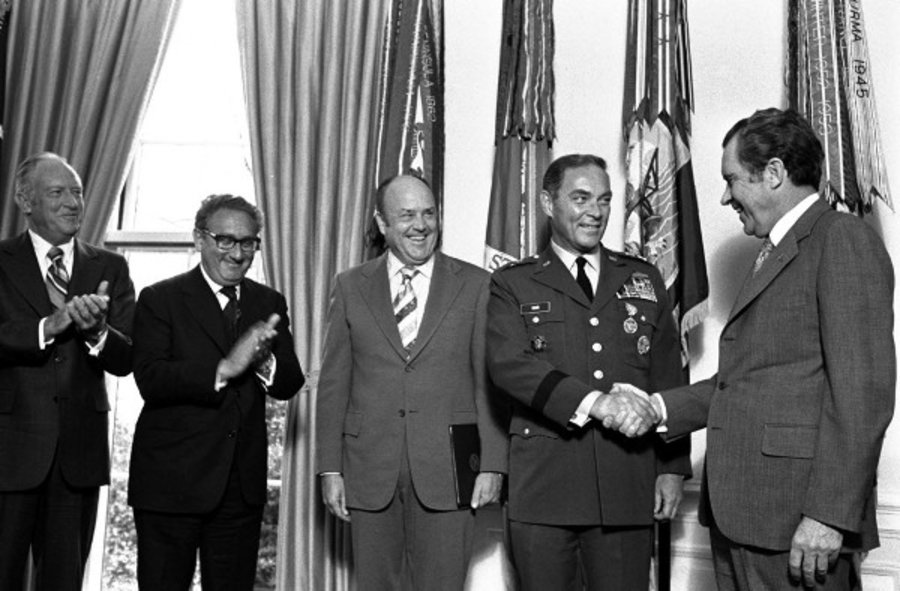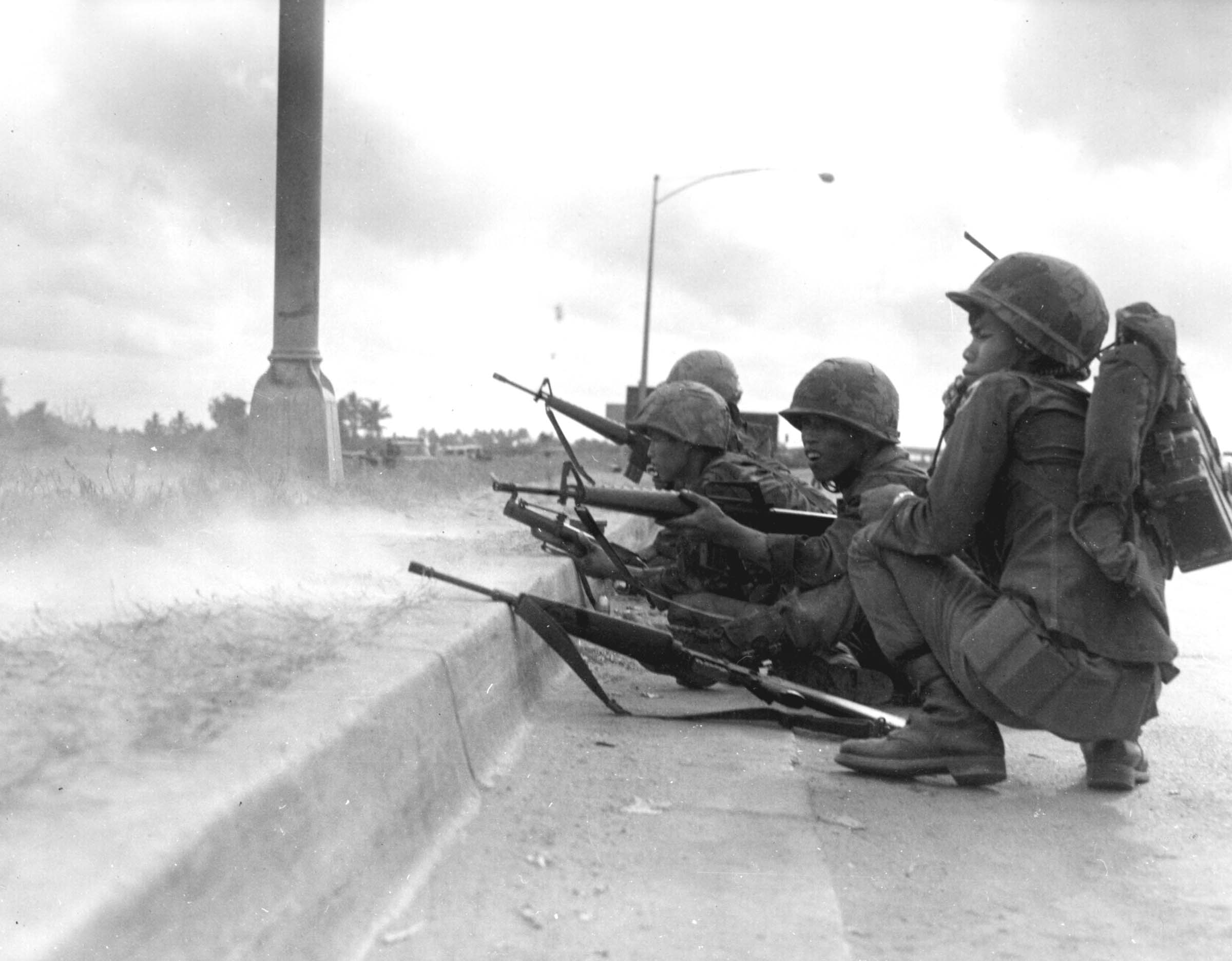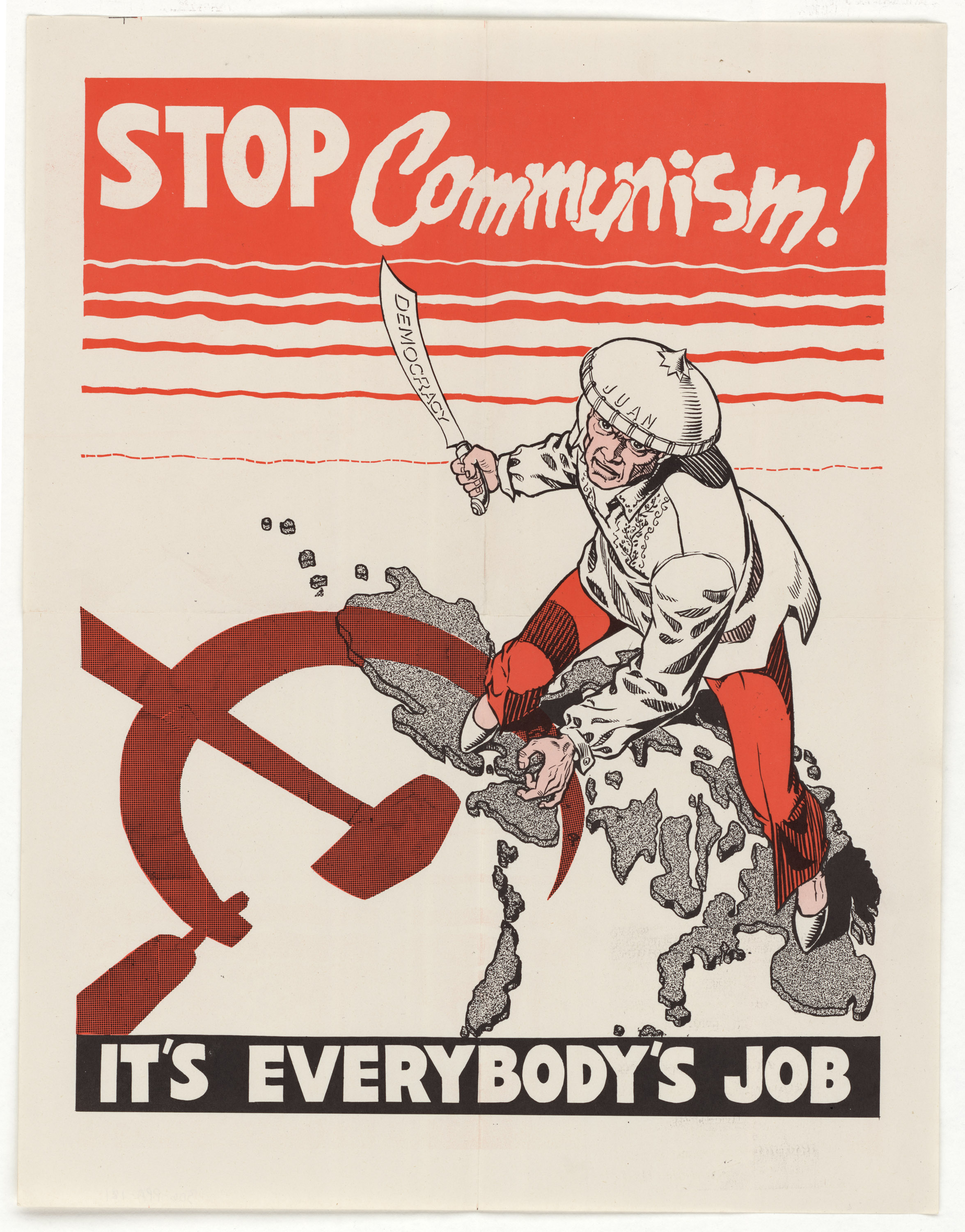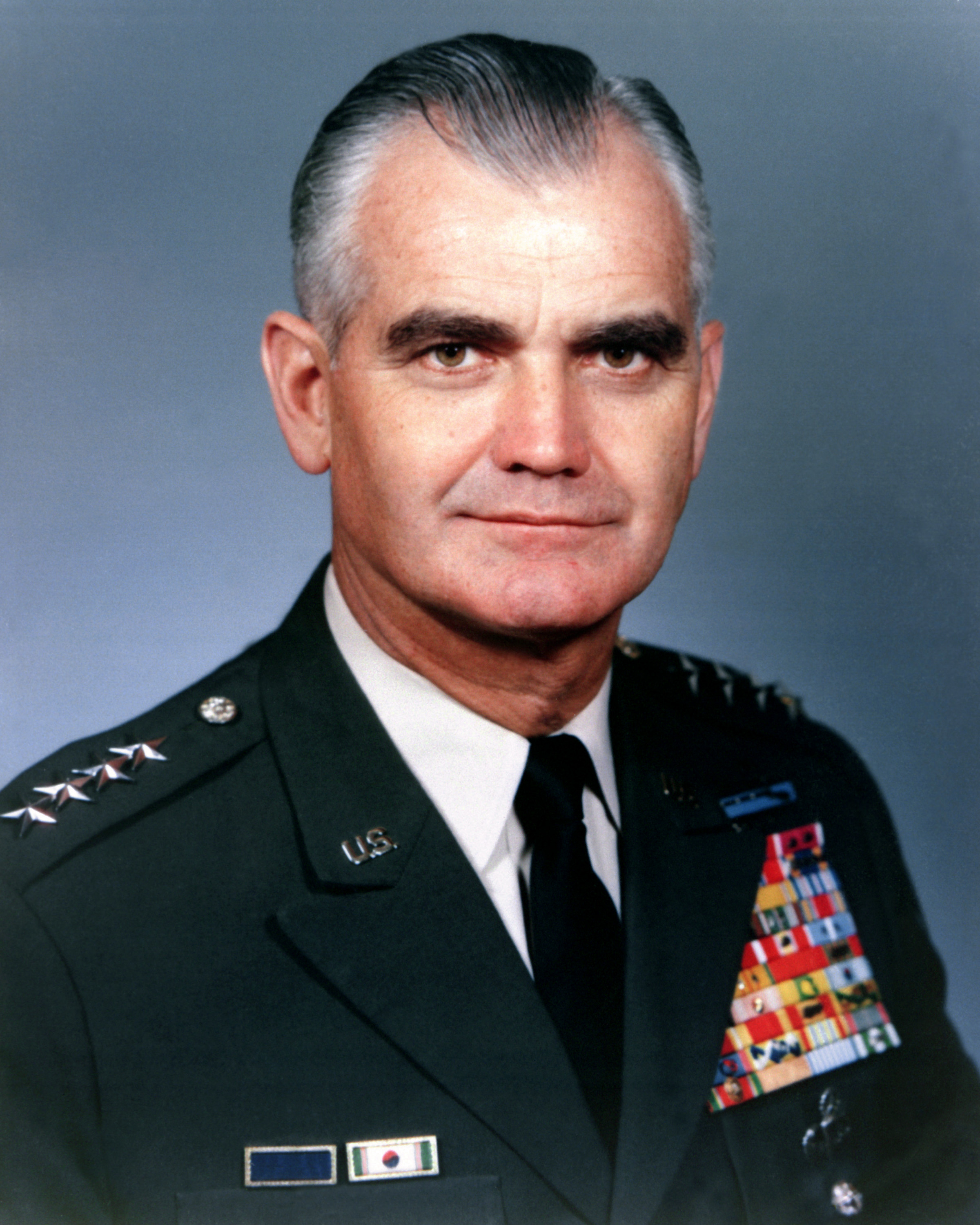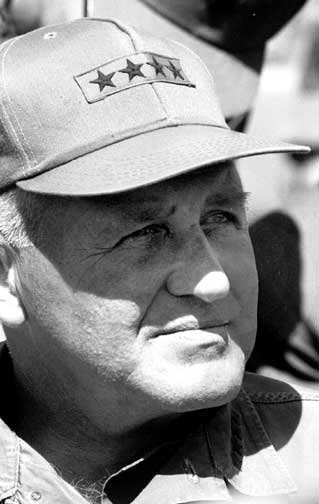|
Vietnamization
Vietnamization was a policy of the Richard Nixon administration to end U.S. involvement in the Vietnam War through a program to "expand, equip, and train South Vietnamese forces and assign to them an ever-increasing combat role, at the same time steadily reducing the number of U.S. combat troops". Brought on by the Viet Cong's Tet Offensive, the policy referred to U.S. combat troops specifically in the ground combat role, but did not reject combat by the U.S. Air Force, as well as the support to South Vietnam, consistent with the policies of U.S. foreign military assistance organizations. U.S. citizens' mistrust of their government that had begun after the offensive worsened with the release of news about U.S. soldiers massacring civilians at My Lai (1968), the invasion of Cambodia (1970), and the leaking of the '' Pentagon Papers'' (1971). At a January 28, 1969, meeting of the National Security Council, General Andrew Goodpaster, deputy to General Creighton Abrams and co ... [...More Info...] [...Related Items...] OR: [Wikipedia] [Google] [Baidu] |
Vietnam War
The Vietnam War (also known by other names) was a conflict in Vietnam, Laos, and Cambodia from 1 November 1955 to the fall of Saigon on 30 April 1975. It was the second of the Indochina Wars and was officially fought between North Vietnam and South Vietnam. The north was supported by the Soviet Union, China, and other communist states, while the south was supported by the United States and other anti-communist allies. The war is widely considered to be a Cold War-era proxy war. It lasted almost 20 years, with direct U.S. involvement ending in 1973. The conflict also spilled over into neighboring states, exacerbating the Laotian Civil War and the Cambodian Civil War, which ended with all three countries becoming communist states by 1975. After the French military withdrawal from Indochina in 1954 – following their defeat in the First Indochina War – the Viet Minh took control of North Vietnam, and the U.S. assumed financial and military support for the South Vietnames ... [...More Info...] [...Related Items...] OR: [Wikipedia] [Google] [Baidu] |
Melvin Laird
Melvin Robert Laird Jr. (September 1, 1922 – November 16, 2016) was an American politician, writer and statesman. He was a U.S. congressman from Wisconsin from 1953 to 1969 before serving as Secretary of Defense from 1969 to 1973 under President Richard Nixon. Laird was instrumental in forming the administration's policy of withdrawing U.S. soldiers from the Vietnam War; he coined the expression " Vietnamization," referring to the process of transferring more responsibility for combat to the South Vietnamese forces. First elected in 1952, Laird was the last surviving Representative elected to the 83rd Congress at the time of his death. Early life Melvin Robert Laird was born in Omaha, Nebraska, the son of Melvin R. Laird Sr., a politician, businessman, and clergyman. He grew up and attended high school in Marshfield, Wisconsin, although in his junior year he attended Lake Forest Academy in Lake Forest, Illinois. He was nicknamed "Bambino" (shortened to "Bom" and pronounc ... [...More Info...] [...Related Items...] OR: [Wikipedia] [Google] [Baidu] |
Presidency Of Richard Nixon
Richard Nixon's tenure as the 37th president of the United States began with his first inauguration on January 20, 1969, and ended when he resigned on August 9, 1974, in the face of almost certain impeachment because of the Watergate Scandal and resigned, the only U.S. president ever to do so. He was succeeded by Gerald Ford, whom he had appointed vice president after Spiro Agnew became embroiled in a separate corruption scandal and was forced to resign. Nixon, a prominent member of the Republican Party from California who previously served as vice president under Dwight D. Eisenhower, took office following the 1968 presidential election, in which he defeated Hubert Humphrey, the then-incumbent vice president. Although he had built his reputation as a very active Republican campaigner, Nixon downplayed partisanship in his 1972 landslide reelection. Nixon's primary focus while in office was on foreign affairs. He focused on détente with the People's Republic of China an ... [...More Info...] [...Related Items...] OR: [Wikipedia] [Google] [Baidu] |
Army Of The Republic Of Vietnam
The Army of the Republic of Vietnam (ARVN; ; french: Armée de la république du Viêt Nam) composed the ground forces of the South Vietnamese military from its inception in 1955 to the Fall of Saigon in April 1975. It is estimated to have suffered 1,394,000 casualties (killed and wounded) during the Vietnam War. The ARVN began as a postcolonial army that was trained by and closely affiliated with the United States and had engaged in conflict since its inception. Several changes occurred throughout its lifetime, initially from a 'blocking-force' to a more modern conventional force using helicopter deployment in combat. During the American intervention, the ARVN was reduced to playing a defensive role with an incomplete modernisation, and transformed again following Vietnamization, it was upgeared, expanded, and reconstructed to fulfill the role of the departing American forces. By 1974, it had become much more effective with foremost counterinsurgency expert and Nixon advi ... [...More Info...] [...Related Items...] OR: [Wikipedia] [Google] [Baidu] |
South Vietnam
South Vietnam, officially the Republic of Vietnam ( vi, Việt Nam Cộng hòa), was a state in Southeast Asia that existed from 1955 to 1975, the period when the southern portion of Vietnam was a member of the Western Bloc during part of the Cold War after the 1954 division of Vietnam. It first received international recognition in 1949 as the State of Vietnam within the French Union, with its capital at Saigon (renamed to Ho Chi Minh City in 1976), before becoming a republic in 1955. South Vietnam was bordered by North Vietnam to the north, Laos to the northwest, Cambodia to the southwest, and Thailand across the Gulf of Thailand to the southwest. Its sovereignty was recognized by the United States and 87 other nations, though it failed to gain admission into the United Nations as a result of a Soviet veto in 1957. It was succeeded by the Republic of South Vietnam in 1975. The end of the Second World War saw anti-Japanese Việt Minh guerrilla forces, led by communist fig ... [...More Info...] [...Related Items...] OR: [Wikipedia] [Google] [Baidu] |
Viet Cong
, , war = the Vietnam War , image = FNL Flag.svg , caption = The flag of the Viet Cong, adopted in 1960, is a variation on the flag of North Vietnam. Sometimes the lower stripe was green. , active = 1954–1959 ''(as southern Viet Minh cadres)'' , ideology = , position = Far-left , leaders = Liberation Army: Central Office: Liberation Front:Burchett, Wilfred (1963):Liberation Front: Formation of the NLF, ''The Furtive War'', International Publishers, New York. Governance: , merged_into = Vietnamese Fatherland Front , clans = , headquarters = , area = Indochina, with a focus on South Vietnam , predecessor = Viet Minh , successor = Vietnam Fatherland Front , allies = , opponents = , battles = See full list The Viet Cong, ; contraction of (Vietnamese communist) was an armed communist organization in South Vie ... [...More Info...] [...Related Items...] OR: [Wikipedia] [Google] [Baidu] |
Containment Policy
Containment was a geopolitical strategic foreign policy pursued by the United States during the Cold War to prevent the spread of communism after the end of World War II. The name was loosely related to the term ''cordon sanitaire'', which was containment of the Soviet Union in the interwar period. As a component of the Cold War, this policy caused a response from the Soviet Union to increase communist influence in Eastern Europe, Asia, Africa, and Latin America. Containment represented a middle-ground position between détente (relaxation of relations) and rollback (actively replacing a regime). The basis of the doctrine was articulated in a 1946 cable by US diplomat George F. Kennan during the post-World War II term of US President Harry S. Truman. As a description of US foreign policy, the word originated in a report Kennan submitted to US Defense Secretary James Forrestal in 1947, which was later used in a magazine article. Earlier uses of term There were major histori ... [...More Info...] [...Related Items...] OR: [Wikipedia] [Google] [Baidu] |
Tet Offensive
The Tet Offensive was a major escalation and one of the largest military campaigns of the Vietnam War. It was launched on January 30, 1968 by forces of the Viet Cong (VC) and North Vietnamese People's Army of Vietnam (PAVN) against the forces of the South Vietnamese Army of the Republic of Vietnam (ARVN), the United States Armed Forces and their allies. It was a campaign of surprise attacks against military and civilian command and control centers throughout South Vietnam. The name is the truncated version of the Lunar New Year festival name in Vietnamese, Tết Nguyên Đán, with the offense chosen during a holiday period as most ARVN personnel were on leave. The purpose of the wide-scale offensive by the Hanoi Politburo was to trigger political instability, in a belief that mass armed assault on urban centers would trigger defections and rebellions. The offensive was launched prematurely in the late night hours of 30 January in the I and II Corps Tactical Zones of Sou ... [...More Info...] [...Related Items...] OR: [Wikipedia] [Google] [Baidu] |
Vietnam
Vietnam or Viet Nam ( vi, Việt Nam, ), officially the Socialist Republic of Vietnam,., group="n" is a country in Southeast Asia, at the eastern edge of mainland Southeast Asia, with an area of and population of 96 million, making it the world's sixteenth-most populous country. Vietnam borders China to the north, and Laos and Cambodia to the west. It shares maritime borders with Thailand through the Gulf of Thailand, and the Philippines, Indonesia, and Malaysia through the South China Sea. Its capital is Hanoi and its largest city is Ho Chi Minh City (commonly known as Saigon). Vietnam was inhabited by the Paleolithic age, with states established in the first millennium BC on the Red River Delta in modern-day northern Vietnam. The Han dynasty annexed Northern and Central Vietnam under Chinese rule from 111 BC, until the first dynasty emerged in 939. Successive monarchical dynasties absorbed Chinese influences through Confucianism and Buddhism, and ex ... [...More Info...] [...Related Items...] OR: [Wikipedia] [Google] [Baidu] |
Creighton Abrams
Creighton Williams Abrams Jr. (September 15, 1914 – September 4, 1974) was a United States Army general who commanded military operations in the Vietnam War from 1968 to 1972, which saw United States troop strength in South Vietnam reduced from a peak of 543,000 to 49,000. He was then Chief of Staff of the United States Army from 1972 until his death in 1974. In 1980, the United States Army named its then new main battle tank, the M1 Abrams, after him. The IG Farben building in Germany was also named after Abrams from 1975 to 1995. Military career Early career Abrams graduated from the United States Military Academy at West Point in the Class of 1936 (ranked 185th of 276 in the class), and served with the 1st Cavalry Division from 1936 to 1940, being promoted to first lieutenant in 1939 and temporary captain in 1940. Abrams became an armor officer early in the development of that branch and served as a tank company commander in the 1st Armored Division in 1940. World W ... [...More Info...] [...Related Items...] OR: [Wikipedia] [Google] [Baidu] |
Military Assistance Command, Vietnam
U.S. Military Assistance Command, Vietnam (MACV) was a joint-service command of the United States Department of Defense. MACV was created on 8 February 1962, in response to the increase in United States military assistance to South Vietnam. MACV was first implemented to assist the Military Assistance Advisory Group (MAAG) Vietnam, controlling every advisory and assistance effort in Vietnam, but was reorganized on 15 May 1964 and absorbed MAAG Vietnam to its command when combat unit deployment became too large for advisory group control. MACV was disestablished on 29 March 1973 and replaced by the Defense Attaché Office (DAO), Saigon. The DAO performed many of the same roles of MACV within the restrictions imposed by the Paris Peace Accords until the Fall of Saigon. The first commanding general of MACV (COMUSMACV), General Paul D. Harkins, was also the commander of MAAG Vietnam, and after reorganization was succeeded by General William C. Westmoreland in June 1964, followed b ... [...More Info...] [...Related Items...] OR: [Wikipedia] [Google] [Baidu] |
Combat Troops
Combat arms (or fighting arms in non-American parlance) are troops within national armed forces who participate in direct tactical ground combat. In general, they are units that carry or employ weapons, such as infantry, cavalry, and artillery units. The use of multiple combat arms in mutually supporting ways is known as combined arms. In some armies, notably the British Army, artillery and combat engineer units are categorized as combat support, while in others, such as the U.S. Army and Canadian Army, they are considered part of the combat arms. Armored troops constitute a combat arm in name, although many have histories derived from cavalry units. Artillery is included as a combat arm primarily based on the history of employing cannons in close combat, and later in the anti-tank role until the advent of anti-tank guided missiles. The inclusion of special forces in some armed forces as a separate combat arm is often doctrinal because the troops of special forces units are es ... [...More Info...] [...Related Items...] OR: [Wikipedia] [Google] [Baidu] |

